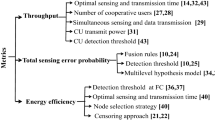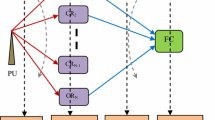Abstract
In cognitive radio, spectrum sensing is a challenging task. In this paper, a spectrum sensing method based on censored observations is proposed. We call it as Censored Anderson Darling (CAD) sensing. We present the performance of the CAD sensing method with receiver operating characteristics (ROC) in fading channels using simulations. It is observed that the proposed method outperforms the conventional energy detection (ED) at lower signal to noise ratio. It also provides better detection performance compared to Ordered Statistics (OS) based sensing method. We also use the CAD sensing method assuming noise uncertainty. It means noise variance at secondary user(SU) is unknown. We call it as Blind CAD sensing (B-CAD). We also show that the B-CAD outperforms the energy detection.






Similar content being viewed by others
References
Haykin, S. (2005). Cognitive radio: brain-empowered wireless communications. IEEE Journal of Selected Areas in Communications, 23(2), 201–220.
Yucek, T., & Arslan, H. (2009). A survey of spectrum sensing algorithms for cognitive radio applications. IEEE Communication Surveys and Tutorials, 11(1), 116–130.
Axell, E., Leus, G., Larsson, E.G., Poor, H.V. (2012). Spectrum sensing for cognitive Radio : state-of-the-art and recent advancesIEEE Signal Processing Magazine, 29(3), 101–116.
Urkowitz, H. (1967). Energy detection of unknown deterministic signals. Proceedings IEEE, 55(4), 523–531.
Wang, H., Yang, E. H., Zhao, Z., Zhang, W. (2009). Spectrum sensing in cognitive radio using goodness of fit testing. IEEE Transactions on Wireless Communications, 8(11), 5427–5430.
Zhang, G., Wang, X., Liang, Y. C., Liu, J. (2010). Fast and robust spectrum sensing via kolmogorov-smirnov test. IEEE Transactions on Communications, 58(12), 3410–3416.
Arshad, K., Briggs, K., Moessner, K. (2011). Robust spectrum sensing for cognitive radio based on statistical tests. ACM 4th International conference cognitive radio and advanced spectrum management (pp. 12:1–12:6). New York.
Rostami, S., Arshad, K., Moessner, K. (2012). Order-statistic based spectrum sensing for cognitive radio. IEEE Communication Letters, 16(5), 592–595.
Agostino, R. D. & Stephens M. (1986). Goodness of fit techniques, ser. statistics: textbooks and monographs. M. Dekker. Available: http://books.google.co.in/books?id=1BSEaGVBj5QC.
Shen, L., Wang, H., Zhang, W., Zhao, Z. (2011). Blind spectrum sensing for cognitive radio channels with noise uncertainty. IEEE Communication Letters, 16(1), 92–94.
Shen, L., Wang, H., Zhang, W., Zhao, Z. (2012). Multiple antennas assisted blind spectrum sensing in cognitive radio channels. IEEE Communication Letter, 16(1), 92–94.
Lawless, J. (2002). Statistical models and methods for lifetime data, ser. Wiley Series in Probability and Statistics. Wiley. Available: http://books.google.co.in/books?id=YsFlQgAACAAJ.
Patel, D. K., & Trivedi, Y. N. (2013). Non-parametric spectrum sensing based on censored observations in quasi-static fading channel for cognitive radio (pp. 108–111). SDR’13-WInnComm-Europe proce.
Pettitt, A. N., & Stephens, M. A (1976). Modified Cramer-von-Mises statistics for censored data. Biometrika, 63, 291–298.
Sonnenschein, A., & Fishman, P. M. (1992). Radiometric detection of spread-spectrum signals in noise of uncertain power. IEEE Transactions on Aerospace and Electronic Systems, 28(3), 654–660.
Gosset, W. S. (1908). The probability of a mean. Biometrika, 6, 1–25.
Lenth, R. V. (1989). Algorithm AS 243: cumulative distribution function of the non-central t distribution. Journal of the Royal Statistical Society, 1, 185–189.
Glen, A. G., Leemis, L. M., Barr, D. R. (2001). Order statistics in goodness-of-fit testing. IEEE Transactions on Reliability, 50(2), 209–213.
Author information
Authors and Affiliations
Corresponding author
Rights and permissions
About this article
Cite this article
Patel, D.K., Trivedi, Y.N. Non-parametric Blind Spectrum Sensing Based on Censored Observations for Cognitive radio. J Sign Process Syst 78, 275–281 (2015). https://doi.org/10.1007/s11265-014-0887-y
Received:
Revised:
Accepted:
Published:
Issue Date:
DOI: https://doi.org/10.1007/s11265-014-0887-y




